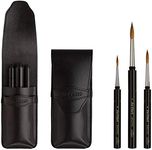Buying Guide for the Best Watercolor Brushes
Choosing the right watercolor brushes is essential for any artist, whether you're a beginner or a seasoned professional. The right brush can make a significant difference in your painting experience and the quality of your artwork. When selecting watercolor brushes, consider the type of work you plan to do, your personal style, and the effects you want to achieve. Understanding the key specifications of watercolor brushes will help you make an informed decision and enhance your painting process.Brush ShapeBrush shape is crucial because it determines the type of strokes you can make. Common shapes include round, flat, filbert, and fan. Round brushes are versatile and can be used for detailed work and broad strokes. Flat brushes are great for bold strokes and filling in large areas. Filbert brushes combine the qualities of flat and round brushes, making them ideal for blending. Fan brushes are used for creating textures. Choose a shape based on the techniques you want to explore and the effects you wish to achieve in your paintings.
Brush SizeBrush size affects the scale of your work and the level of detail you can achieve. Sizes are usually indicated by numbers, with smaller numbers representing smaller brushes. Small brushes (sizes 0-4) are perfect for fine details and intricate work. Medium brushes (sizes 5-8) are versatile for both detail and larger areas. Large brushes (sizes 9 and above) are best for washes and covering large areas quickly. Consider the size of your canvas or paper and the level of detail you want to incorporate when selecting brush sizes.
Bristle MaterialThe bristle material affects the brush's performance and durability. Natural bristles, such as sable or squirrel, are known for their excellent water retention and smooth application, making them ideal for professional artists. Synthetic bristles are more affordable and durable, suitable for beginners or those who prefer a firmer brush. Some brushes combine both natural and synthetic fibers for a balance of performance and cost. Choose based on your experience level, budget, and the type of painting you plan to do.
Handle LengthHandle length can influence your comfort and control while painting. Short handles are typically used for watercolor brushes, offering better control for detailed work and allowing you to work closely to the paper. Long handles are more common in other painting mediums but can be used for watercolor if you prefer a looser style and more distance from your work. Consider your painting style and the level of control you desire when choosing handle length.
Brush TipThe tip of the brush affects the precision and type of marks you can make. A fine, pointed tip is essential for detailed work and delicate lines, while a broader tip is better for washes and broader strokes. Some brushes have a chiseled tip for creating sharp edges and lines. Consider the type of work you do most often and the level of detail you require when selecting a brush tip.


















